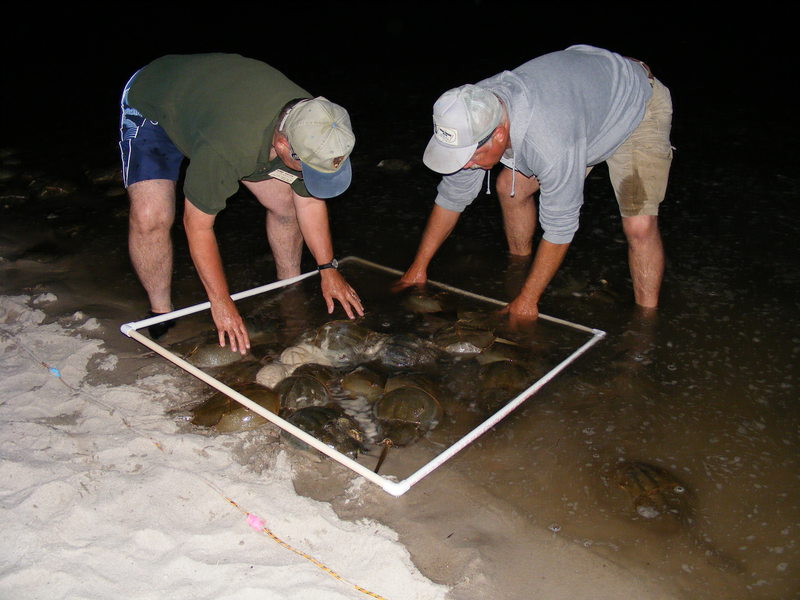Volunteers have hit the beach each full and new moon this spring, counting how many horseshoe crabs spawn on a square meter of Inland Bays beaches. What they've discovered, since the counts began in 2007, is that the Inland Bays are a significant breeding ground for horseshoe crabs.
University of Delaware graduate student Emily Maung said the counts show about the same number of horseshoe crabs spawn per meter of beach in the Inland Bays as they have along Delaware Bay beaches. Put more scientifically, she said the spawning densities on Inland Bays and Delaware Bay beaches are statistically the same. Still, while the density is similar, the number of crabs in Delaware Bay is larger because the bay is much larger than the Inland Bays.
Counting started in May, said Dennis Bartow, schoolyard habitat coordinator for the Center for the Inland Bays, which is coordinating the survey with the University of Delaware. Volunteers are helping scientists determine both how many horseshoe crabs spawn in the bays and where they travel.
Volunteers use a square of plastic pipe to outline each square meter they count.
"We start two days before the new moon, count on the new moon and two days after it. We do the same for the full moon," Bartow said. Surveys have been taken along 1.5 kilometers of bay beaches, at a total of seven sites, Bartow said.
Bartow's team counted spawning horseshoe crabs on the beaches at the center's James Farm Ecological Preserve. One evening, they counted more than 2,700 crabs on the sand a meter up from the shoreline.
That's more than last year at about the same location, Bartow said.
The center is examining the male-to-female ratio of the crabs, as well as the density at which they spawn, said Bartow. They are trying to amass an overall picture of the health of the horseshoe crab population in the bays, he said.
Maung said the Inland Bays had not been recognized as having a lot of horseshoe crabs before counts began in 2007. She said surveys, begun by University of Delaware professor Doug Miller, are showing that what locals have said about the horseshoe crab population is true.
Bartow said, "Our data is very consistent with data found in the Delaware Bay. We are trying to do a comprehensive study and make the point that our population is a significant population, and the Inland Bays are a significant breeding ground." The survey will help the center educate the public on horseshoe crabs, he said.
So far, scientists are looking at just the crabs, not the shorebirds that feed on their eggs, although Bartow said the eggs are a crucial food source for birds that live in and migrate through the area.
A female horseshoe crab can lay as many as 880,000 eggs in a season, Bartow said. "They only have to have one male and one female mature to breeding age for replacement, but because the eggs are not protected they produce a tremendous number of them to ensure that one survives to reproductive maturity," said Bartow.
Horseshoe crabs are also an important indicator of the health of a waterway system.
They feed on bottom-dwelling animals, including worms and clams, Bartow said. "If the bay isn't healthy, it won't have that food source for them," he said.
Horseshoe crab tagging and tracking
Volunteers have also been tagging horseshoe crabs. Bartow said a team tagged 200 crabs one evening, and found more than 40 percent of them back on the beach the next night. But, two days later, just 1 percent were on the beach, he said.
"They go in and out of the bay and travel up and down along the coast," Bartow said. "We will get a mix from all up and down the East Coast."
Bartow said horseshoe crabs tagged in Cape May, Ocean City, Wallops Island and Chincoteague have turned up in the Inland Bays.
"We've had a lot of enthusiasm from the public to come as volunteers and to come observe what's being done," Bartow said. Those observing the work include a scientist from the Smithsonian Institution and student rangers and interns from Assateague National Wildlife Area, Bartow said.
The Center for the Inland Bays is online at inlandbays.org.



















































